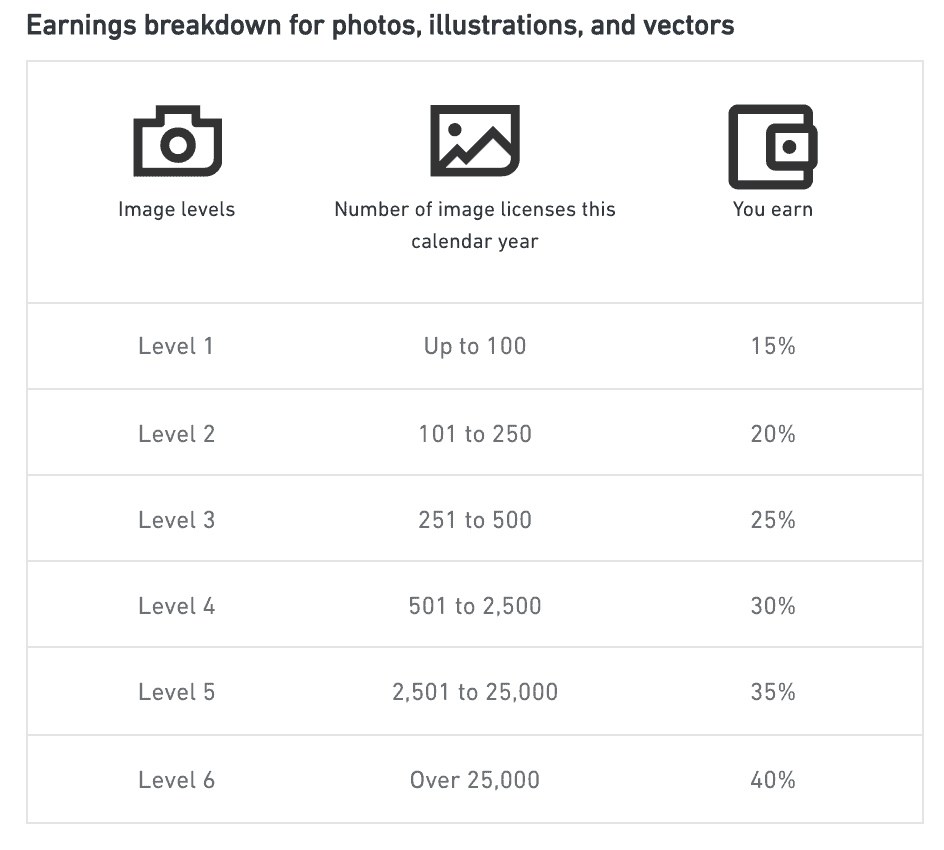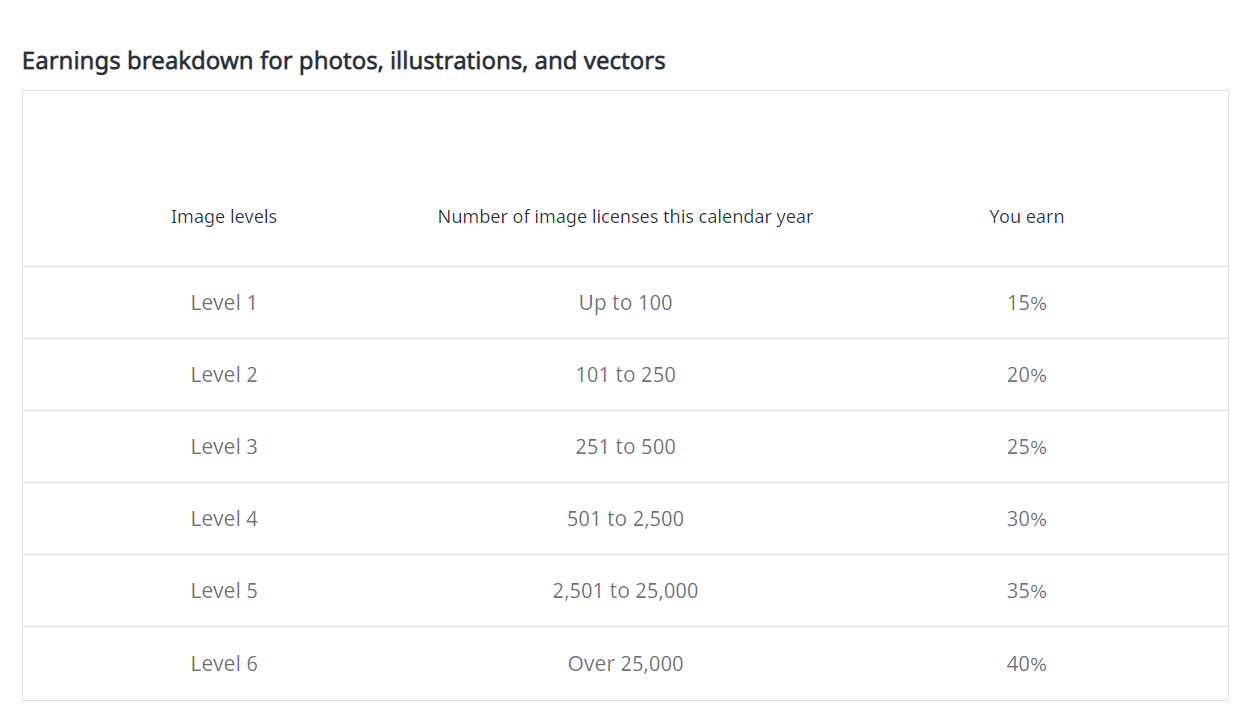Thinking about turning your photography passion into a source of income? The Shutterstock Contributor Program is a popular platform where photographers, illustrators, and videographers can showcase their work and earn money whenever someone downloads their content. It’s a great way for creative minds to monetize their skills and reach a global audience. Whether you’re just starting out or already have a vast portfolio, understanding how the program works and how you get paid is key to making the most of this opportunity. Let’s dive into what makes Shutterstock a go-to choice for contributors around the world.
How Shutterstock Pays Contributors

So, you’ve uploaded some fantastic photos and are wondering, “How exactly does Shutterstock pay me?” Well, here’s the scoop: Shutterstock’s payment system primarily revolves around a royalty-based model, meaning the more downloads your images get, the more you earn. Your earnings are calculated based on your contributor level, which is influenced by your total lifetime earnings and the number of downloads.
Here’s a quick breakdown of how payments work:
- Royalty Rates: Shutterstock offers different royalty rates depending on your contributor level and the type of license purchased (Standard or Enhanced). As you earn more and meet certain milestones, your royalty rate can increase.
- Payment Thresholds: You need to reach a minimum payout amount—usually $35—to receive your earnings. Once you hit this threshold, Shutterstock processes your payment via PayPal or other available methods.
- Revenue Share: Shutterstock typically takes a commission from the sale, and you receive the remaining percentage as your royalty. The exact split depends on your contributor level and the license type.
- Subscription vs. On-Demand Sales: Shutterstock offers both subscription plans (monthly or annual) and on-demand purchases. Generally, earnings per download are higher for on-demand sales, but subscription downloads are more frequent, which can balance out your overall income.
Additionally, Shutterstock has a tiered contributor program, starting from Standard and progressing to Premium levels as you accumulate more downloads and earnings. Higher tiers unlock increased royalty rates, so consistently uploading high-quality content can boost your income over time.
In summary, Shutterstock’s payment system is designed to reward active contributors with increasing earnings potential. By understanding the structure—royalty rates, payment thresholds, and license types—you can better strategize your uploads and optimize your earnings from this vibrant platform.
3. Factors That Influence Contributor Earnings

When it comes to earning money as a Shutterstock contributor, several factors come into play. It’s not just about uploading high-quality images and hoping for the best — understanding what influences your earnings can help you optimize your portfolio and potentially boost your income.
First up, license type matters a lot. Shutterstock offers two main types of licenses: Standard and Enhanced. Standard licenses are more common and generally generate lower royalties, while Enhanced licenses, which are purchased for bigger projects or commercial uses, come with higher payout potential. So, if your images are suitable for bigger commercial use, aiming for those licenses can make a difference.
Another key factor is download volume. The more your images are downloaded, the more you earn. It’s pretty straightforward — popular photos tend to earn more because they attract more buyers over time. Consistently uploading fresh, relevant content helps keep your portfolio active and visible, which can increase downloads.
Image quality and relevance are also crucial. Shutterstock has strict standards for quality, so high-resolution, well-composed, and properly edited images are more likely to get accepted and downloaded. Additionally, using accurate keywords and tags helps your images show up in search results. Think of it like making your photos easy to find for customers who are searching for exactly what you offer.
Contributor level and exclusivity can influence your earnings as well. Shutterstock has a tiered contributor program, and as you upload more and earn more, you move up levels, unlocking higher royalty rates. Also, if you choose to be exclusive — meaning you only sell your images through Shutterstock — you might be eligible for higher payouts, but that’s a personal choice based on your overall strategy.
Lastly, timing and trending topics play a role. Uploading images related to current events, seasonal themes, or trending topics can lead to more downloads in a short period. Staying on top of what’s popular can give you an edge in earning more.
4. Average Payment Rates for Photos on Shutterstock

So, what can you realistically expect to earn per download on Shutterstock? The truth is, payment rates vary depending on several factors, including your contributor level, license type, and whether you are exclusive or non-exclusive. But to give you a ballpark idea, here’s an overview of typical rates:
| Contributor Level | Standard License | Enhanced License |
|---|---|---|
| New Contributor | $0.25 – $0.50 | $0.50 – $1.50 |
| Mid-Level Contributor | $0.50 – $1.00 | $1.50 – $4.00 |
| Advanced Contributor | $1.00 – $2.00 | $4.00 – $10.00+ |
As you can see, the more you advance in level, the higher your earnings per download. Plus, if you opt for exclusive participation, you might see increased rates, especially for higher license types.
Keep in mind, these rates are approximate and can fluctuate based on your total downloads, license types purchased, and the specifics of each sale. Many contributors find that their average earning per download hovers around $0.25 to $2.00 for standard licenses, but this can increase significantly for popular images or exclusive content.
Ultimately, earning well on Shutterstock involves a combination of uploading quality, relevant images, understanding licensing, and actively optimizing your portfolio. With patience and strategic effort, you can turn your photography hobby into a steady income stream.
5. Tips to Maximize Your Earnings as a Shutterstock Contributor
So, you’re eager to boost your earnings as a Shutterstock contributor—awesome! Making the most out of your photos isn’t just about uploading a ton of images; it’s about strategic effort and smart choices. Here are some practical tips to help you maximize your income:
Choose Your Niche Wisely
Focus on a niche or subject you’re passionate about and that has consistent demand. Whether it’s lifestyle, technology, business, or nature, specializing can help you become a go-to contributor in that area, increasing your chances of sales.
Upload High-Quality, Relevant Content
Quality trumps quantity. Make sure your photos are sharp, well-lit, and composed professionally. Also, stay updated with current trends—images that match what buyers are searching for tend to sell more often.
Keyword Smartly
Accurate and descriptive keywords are your best friends. Use all available keyword slots and think like a buyer—what would someone search for to find your photo? The more relevant your keywords, the higher your visibility.
Offer a Variety of Content
Have a mix of images—people, landscapes, business settings, digital technology, etc. This diversity can attract different kinds of buyers and increase your chances of multiple sales from a single upload session.
Stay Consistent and Active
Regular uploads keep your portfolio fresh and relevant. Shutterstock tends to favor active contributors, and the more you contribute, the more opportunities you have to earn.
Engage with the Community and Trends
Follow trending topics and popular search terms. Participating in challenges or seasonal themes can give your work extra exposure. Also, engaging with the community can give you insights and tips from fellow contributors.
Monitor Your Performance
Use the Contributor Dashboard to see which images are performing well. Focus on creating more content in those areas and refine your keyword strategies based on what sells best.
Optimize for Different License Types
Understand the difference between royalty-free and enhanced licenses. Sometimes, offering images that qualify for enhanced licenses can boost your earnings per sale.
Remember, patience is key. Building a solid portfolio and understanding what buyers want takes time, but with perseverance and strategic effort, you can significantly increase your Shutterstock earnings.
6. Conclusion and Final Thoughts on Shutterstock Photo Payments
Understanding how Shutterstock pays its contributors can seem a bit complex at first, but once you get the hang of it, it’s a straightforward process. Your earnings depend on various factors like the type of license sold, the size of your image, and your contributor level. The more you contribute high-quality, relevant images, the better your chances of earning more.
It’s important to remember that Shutterstock’s payment structure rewards consistency and strategic effort. By focusing on creating appealing, keyword-rich images and staying active on the platform, you can gradually build a steady income stream. Keep an eye on trends, optimize your portfolio, and don’t be discouraged by slow starts—success in stock photography often comes with patience and persistence.
Finally, consider your long-term goals. Whether you’re looking to earn part-time income or turn stock photography into a full-time gig, understanding the payout system helps you set realistic expectations and plan your content creation accordingly.
So, keep shooting, keep learning, and enjoy the journey of turning your creative passion into a rewarding source of income. Happy contributing!


